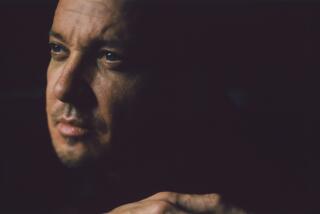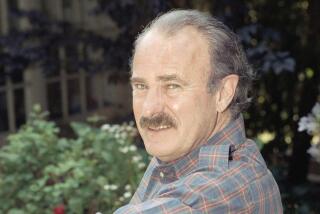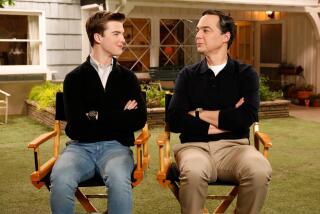Intersection of car and camera
What Ansel Adams did for Yosemite, Los Angeles photographer Robbert Flick did for a parking garage in Inglewood. He made the place into the object of his obsession and the focus of his commanding technical skill, and in the process he transformed it into a site of exquisite wonder for us.
A generous selection of Flick’s parking garage pictures is included in the absorbing retrospective survey of his work that opened this week at the Los Angeles County Museum of Art. In his noteworthy career, the suite emerges as a critical turning point.
Obviously there are some differences between Half Dome and parking level 3. One is unique, the other prosaic. But the humdrum anonymity of Flick’s raw subject matter only serves to makes his gorgeous prints more impressive. (Ask yourself: Have you ever seen a truly bad photograph of spectacular Disney Concert Hall?) The subject of parking structures is universal in the modern world, while also standing as an icon for the distinctive urban experience that Los Angeles represents. Flick’s notion of photographing inside a parking garage was not a gimmick or a passing fancy.
For more than two years -- 1977 through 1979 -- he lugged his cameras, lenses, tripods and other photographic equipment to the multistory concrete structure near his studio, like Carleton Watkins trudging into the woods, and he photographed no other landscape. No cars or people intrude upon the pristine wilderness of this parking structure. It’s “an unsettled, uncultivated region left in its natural condition,” as my dictionary defines such a place.
And it’s gorgeous -- a complex construction of imposing planar walls, taut steel cables and orthogonal spaces composed on a multidimensional grid. The labyrinth is infused with a mixture of natural and fluorescent light, which the artist manipulates in the rich tonalities of his exquisite black and white prints. Scuffed pavement, cinder block walls, concrete pillars and directional signs emerge with the physical dignity and emotional gravity of the Pantheon in Rome or the Temple of Quetzalcoatl at Teotihuacan. Except for an occasional glimpse of sky, nothing but a man-made environment is ever seen.
That’s probably the biggest difference between Flick’s parking structure and Adams’ Yosemite. The Angeleno is incisively photographing within a landscape shaped by the organizing principle of the automobile, rather than the organic template of nature. This is its shrine.
In fact two modern machines intersected in the making of Flick’s art -- the car and the camera. He calls attention to both simultaneously -- the unseen car through subject matter and the unseen camera through a combination of obviously artful composition, exquisite printing technique and frank visual acknowledgment of the pictorial tradition of artistic landscape photography (including Watkins and Adams). Never coy, condescending or ironic, the photographs are instead epic -- even primeval. His pictures record the junction of car and camera with sincerity and reverence.
And, why not? It’s the monumental landscape within which we live.
Flick occupies a significant position among a host of important artists -- including Edward Ruscha, Judy Fiskin, Anthony Hernandez, Cathy Opie and several others -- who have used their cameras in the past 50 years to intersect with the extraordinary landscape of Los Angeles. (Speaking of which: Would someone please organize a show?) There is also a loose relationship to the New Topographics photography that burst onto the scene in 1975, exploring how the visible world arises from invisible social structures.
Still, if there’s one photographer to whom his work owes a debt deeper than any other, it is Robert Heinecken, Flick’s teacher at UCLA in the late 1960s. No one would mistake a Flick photograph for a Heinecken photograph. That’s because conceptual structure, not formal style, is what links the two.
Heinecken was among the first to engage photographs as something other than individual images proclaiming unique power and authenticity. By the 1960s the flow of camera pictures encountered in daily life had reached the volume (and velocity) of a roaring flood, so Heinecken began an inquiry into what happens in the routine collisions between them.
In one notable body of work he let the images on two sides of commercially produced magazine pages bleed into each other. In the visual conversation between the pictures, accidental commentaries on topical issues arose amid surreal ghosts.
Heinecken’s photographic intersections are promiscuous, like the popular culture that produces the images he manipulates.
Flick’s are chaste -- more austere and simpler in design -- yet no less enigmatic. And, as the extensive parking structure series shows, the artist quickly arrived at a position in which each individual photograph contains within it the oblique suggestion that it is only one among countless possibilities. Despite industrial uniformity, parking level 3 is not the same as parking level 4. No photograph stands alone as definitive.
Perhaps it required an out-of-towner to perceive the singular landscape of Los Angeles in quite the way Flick has. Born in the Netherlands (in 1939), he grew up there and in the Dutch West Indies, immigrating to Vancouver with his family at 18. (Sometimes when I look at the luminous, shifting planes in the parking lot photographs, I see visual echoes of stringent 17th century Dutch paintings of unadorned church interiors.) Nearly 30 by the time he got to UCLA, Flick brought a mature perspective to his graduate study.
The LACMA exhibition, deftly selected and handsomely installed by curator Tim B. Wride, brings together 85 works dating from 1969 to 2001. The “Arena Series,” which is the formal title for the parking garage pictures, is partly anticipated by a lovely group of pictures made while Flick was an instructor at a rural campus of the University of Illinois. (He has taught at USC since 1976.) The “Midwest Diary” consists of meticulously organized landscapes of wide-open spaces.
These farmland images are almost always composed around a central element -- a farmhouse dwarfed by boundless fields, a weathered tombstone, a splintered tree stump, the light pole outside a roadside tavern. Sometimes that central element is nothing but strongly articulated negative space, such as the path between dense rows of corn or the place where snow-dusted furrows intersect in a plowed field.
The central element functions as a visual spindle. Like a vinyl record on a turntable or the Earth rotating on its axis, the vast and empty landscape turns around it. Space, although articulated in flat planes, seems curved. Without a living human being anywhere in sight, motion and shifting viewpoints are subtly implied.
They’re underscored in the work Flick began to make after the “Arena Series,” where the artist traded in Urbana-Champaign for L.A., and for which he is best-known today. Motion and shifting viewpoints are intrinsic to these large-scale pieces.
A single sheet of paper is subdivided into a grid of black and white or, since 1990, color photographs. The landscape of Los Angeles is recorded in a pictorial composition based on the street grid. In the color works, hundreds of frames are juxtaposed to evoke passage through the landscape -- not on foot, but on wheels.
Normally, street photography is thought of as a pedestrian activity. By contrast Flick’s portraits of L.A. streets are made with a video camera mounted on the rear of his car’s driver’s seat, aimed at a 90-degree angle out the side window. It’s the city at 30 mph, framed by automobile.
You know how a traffic route taken every day suddenly looks different when you’re the passenger, not the driver? That happens in Flick’s “L.A. Documents,” some of which are as large as 5 feet across. Pico Boulevard, Broadway, Melrose and Central avenues, despite their ordinariness, the L.A. streets become alien, exhilarating and radiantly strange.
The experience of looking at these composite grids contributes to the buoyant stimulation. The initial tendency is for your eye to follow the linear directions across the grid, horizontally or vertically. Sometimes you decide to make a right or left turn, as you do while driving.
Eventually, though, your eye begins to wander. It slips and slides across the jumbled pictorial surface, alighting on fragmentary urban scenes at random. This diffuse visual encounter with the picture of an automotive city approaches the one you have behind the wheel. The difference is that, here, you can linger anyplace as long as you choose, without getting honked at for impeding the flow of traffic.
Rarely if ever has the distinctive perceptual nature of seeing Los Angeles been so succinctly captured -- and illuminated -- in works of art. Flick’s best photographs brim with a sense of discovery about something that you think you already know.
*
‘Robbert Flick: Trajectories’
Where: Los Angeles County Museum of Art, 5905 Wilshire Blvd.
When: Closed Wednesdays
Ends: Jan. 9
Price: Adults $9
Contact: (323) 857-6000
More to Read
The biggest entertainment stories
Get our big stories about Hollywood, film, television, music, arts, culture and more right in your inbox as soon as they publish.
You may occasionally receive promotional content from the Los Angeles Times.







